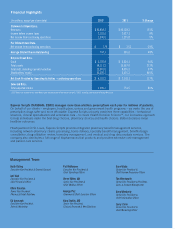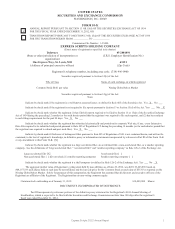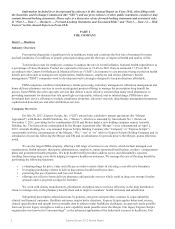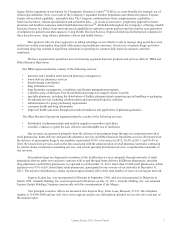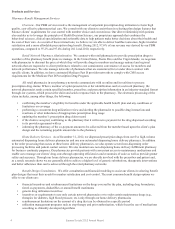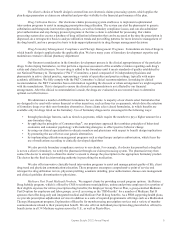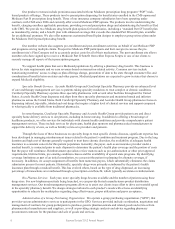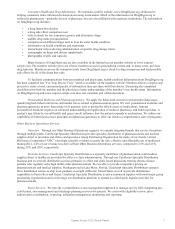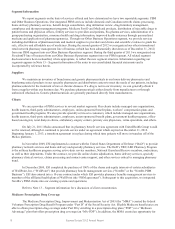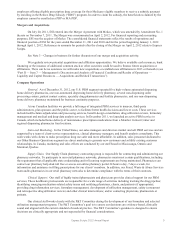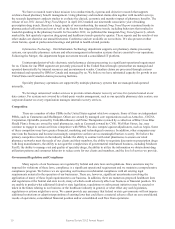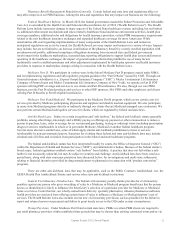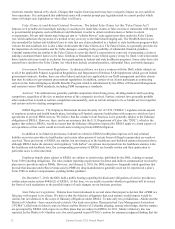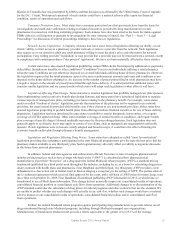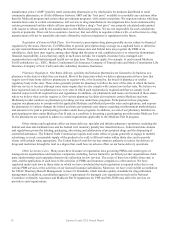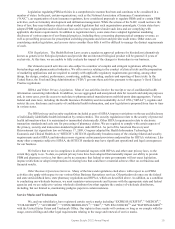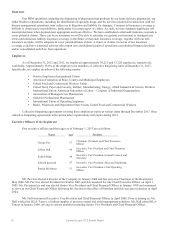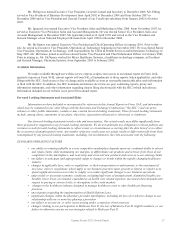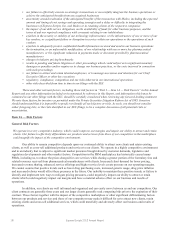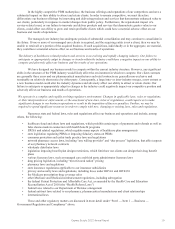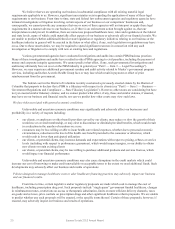Express Scripts 2012 Annual Report Download - page 12
Download and view the complete annual report
Please find page 12 of the 2012 Express Scripts annual report below. You can navigate through the pages in the report by either clicking on the pages listed below, or by using the keyword search tool below to find specific information within the annual report.Express Scripts 2012 Annual Report10
9
We have a research team whose mission is to conduct timely, rigorous and objective research that supports
evidence-based pharmacy benefit management. Using pharmacy and medical claims data together with member surveys,
the research department conducts studies to evaluate the clinical, economic and member impact of pharmacy benefits. The
release of our 2011 Annual Drug Trend Report in April 2012 marked our nineteenth consecutive year of tracking
prescription drug trends. Based on a large sample of our membership, the annual Drug Trend Report examined trends in
pharmaceutical utilization and cost as well as the factors that triggered those trends, including behaviors that resulted in
wasteful spending in the pharmacy benefit. In November 2012, we published the inaugural Drug Trend Quarterly, which
marked the first quarterly report on drug spend and healthcare trends quarter by quarter. These reports and the results of our
other studies are shared at our annual Outcomes Conference and are available on our website. We also present at other
client forums, speak at professional meetings and publish in health-related journals.
Information Technology. Our Information Technology department supports our pharmacy claims processing
systems, our specialty pharmacy systems and other management information systems that are essential to our operations.
Following the Merger, this department began movement toward a consolidated IT platform.
Uninterrupted point-of-sale electronic retail pharmacy claims processing is a significant operational requirement
for us. Claims for our PBM segment are presently processed in the United States through systems that are managed and
operated domestically by internal resources and an outsourced vendor. Canadian claims are processed through systems
maintained and operated by IBM in Canada and managed by us. We believe we have substantial capacity for growth in our
United States and Canadian claims processing facilities.
Specialty pharmacy operations are supported by multiple pharmacy systems that are managed and operated
internally.
We leverage outsourced vendor services to provide certain disaster recovery services for systems located at our
data centers. For systems not covered by a third-party vendor arrangement, such as our specialty pharmacy data centers, our
corporate disaster recovery organization manages internal recovery services.
Competition
There are a number of other PBMs in the United States against which we compete. Some of these are independent
PBMs, such as Catamaran and MedImpact. Others are owned by managed care organizations such as Aetna Inc., CIGNA
Corporation, OptumRx (owned by UnitedHealthcare) and Prime Therapeutics (owned by a collection of Blue Cross Blue
Shield Plans). Some are owned by retail pharmacies, such as Caremark (owned by CVS). Wal-Mart Stores, Inc. may
continue to engage in certain activities competitive with PBMs. We also compete against adjudicators, such as Argus. Some
of these competitors may have greater financial, marketing and technological resources. In addition, other companies may
enter into the business and become increasingly competitive as there are no meaningful barriers to entry. We believe the
primary competitive factors in the industry include the ability to contract with retail pharmacies to ensure our retail
pharmacy networks meet the needs of our clients and their members, the ability to negotiate discounts on prescription drugs
with drug manufacturers, the ability to navigate the complexities of governmental reimbursed business, including Medicare
Part D, the ability to manage cost and quality of specialty drugs, the ability to utilize the information we obtain about drug
utilization patterns and consumer behavior to reduce costs for our clients and members, and the level of service we provide.
Government Regulation and Compliance
Many aspects of our businesses are regulated by federal and state laws and regulations. Since sanctions may be
imposed for violations of these laws, compliance is a significant operational requirement and we maintain a comprehensive
compliance program. We believe we are operating our business in substantial compliance with all existing legal
requirements material to the operation of our businesses. There are, however, significant uncertainties involving the
application of many of these legal requirements to our business. In addition, there are numerous proposed healthcare laws
and regulations at the federal and state levels, many of which could adversely affect our business or financial position. We
are unable to predict what additional federal or state legislation, regulations or enforcement initiatives may be enacted or
taken in the future relating to our business or the healthcare industry in general, or what effect any such legislation,
regulations or actions might have on us. We cannot provide any assurance that federal or state governments will not impose
additional restrictions or adopt interpretations of existing laws that could have a material adverse effect on our consolidated
results of operations, consolidated financial position and/or consolidated cash flow from operations.


